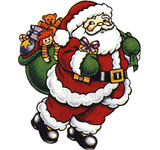 The American version of the Santa Claus figure received its
inspirationand its name from the Dutch legend of Sinterklaas (a Dutch
variantof the name Saint Nicholas). The American version of the Santa Claus figure received its
inspirationand its name from the Dutch legend of Sinterklaas (a Dutch
variantof the name Saint Nicholas).
Dutch colonists took this tradition with them to New Amsterdam (now New York City) in the American colonies in the 17th century.
As early as 1773 the name appeared in the American
pressas "St. A Claus," but it was the popular author Washington Irving who gave Americans their first detailed information about the Dutch version of Saint Nicholas. In his History of New York, published in 1809 under the
pseudonymDiedrich Knickerbocker, Irving described the arrival of the saint on horseback each Eve of Saint Nicholas.
This Dutch-American Saint Nick achieved his fully Americanized form in 1823 in the poem A Visit From Saint Nicholas more commonly known as "The Night Before Christmas" by writer Clement Clarke Moore. Moore included such details as the names of the reindeer; Santa Claus's laughs,
winks, and nods.
The American image of Santa Claus was further elaborated by illustrator Thomas Nast, who
depicteda
rotundSanta for Christmas issues of Harper's magazine from the 1860s to the 1880s. Nast added such details as Santa's workshop at the North Pole and Santa's list of the good and bad children of the world. In the first Nast illustration, Santa was delivering Christmas gifts to soldiers fighting in the Civil War. The cartoon, entitled "Santa Claus in Camp" appeared in Harper's Weekly on January 3, 1863.
A human-sized version of Santa Claus, rather than the
elfof Moore's poem, was depicted in a series of illustrations created by Haddom Sundblom for Coca-Cola advertisements introduced in 1931. In modern versions of the Santa Claus legend, only his
toyshopworkers are elves.
An advertising writer named Robert May, invented Rudolph, the ninth reindeer, with a red and shiny nose, while working on a catalog for the Montgomery Ward Company in 1939.
In looking for the historical roots, one discovers that Santa Claus, as we know him, is a combination of many different legends and
mythical creatures.
The basis for the Christian-era Santa Claus is Bishop Nicholas of Smyrna (Izmir), in what is now Turkey. Nicholas lived in the 4th century A.D. He was very rich, generous, and loving toward children. Often he gave joy to poor children by throwing gifts in through their windows.
The
Orthodox Churchlater raised St. Nicholas, miracle worker, to a position of great esteem. It was in his honor that Russia's oldest church, for example, was built. For its part, the Roman Catholic Church honored Nicholas as one who helped children and the poor. St. Nicholas became the
patron saintof children and
seafarers. His
name dayis December 6th.
In the
Protestantareas of central and northern Germany, St. Nicholas later became known as der Weinachtsmann. In England he came to be called Father Christmas. St. Nicholas made his way to the United States with Dutch immigrants, and began to be referred to as Santa Claus.
In North American poetry and
illustrations, Santa Claus, in his white beard, red jacket and pompom-topped cap, would
sally forthon the night before Christmas in his sleigh, pulled by eight reindeer, and climb down chimneys to leave his gifts in stockings children set out on the fireplace's
mantelpiece.
Children naturally wanted to know where Santa Claus actually came from. Where did he live when he wasn't delivering presents? Those questions gave rise to the legend that Santa Claus lived at the North Pole, where his Christmas-gift workshop was also located.
|